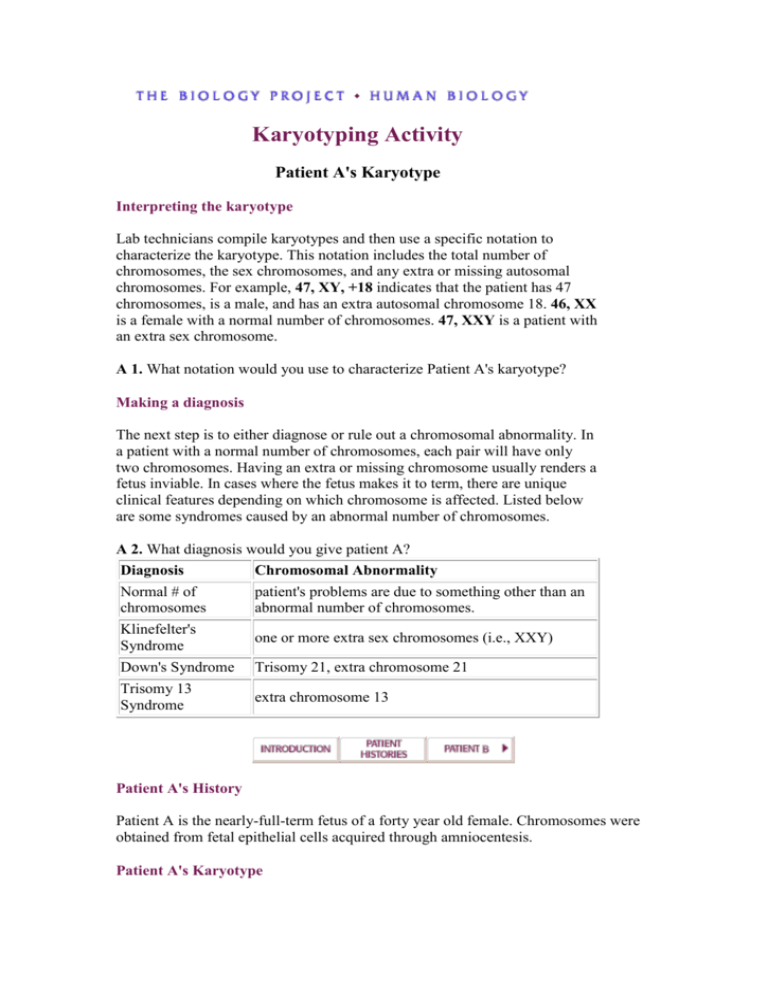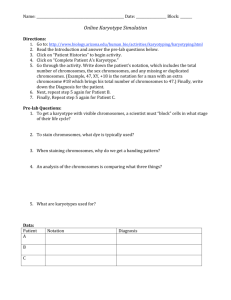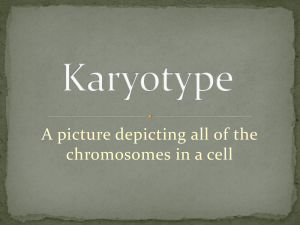
Karyotyping Activity
Patient A's Karyotype
Interpreting the karyotype
Lab technicians compile karyotypes and then use a specific notation to
characterize the karyotype. This notation includes the total number of
chromosomes, the sex chromosomes, and any extra or missing autosomal
chromosomes. For example, 47, XY, +18 indicates that the patient has 47
chromosomes, is a male, and has an extra autosomal chromosome 18. 46, XX
is a female with a normal number of chromosomes. 47, XXY is a patient with
an extra sex chromosome.
A 1. What notation would you use to characterize Patient A's karyotype?
Making a diagnosis
The next step is to either diagnose or rule out a chromosomal abnormality. In
a patient with a normal number of chromosomes, each pair will have only
two chromosomes. Having an extra or missing chromosome usually renders a
fetus inviable. In cases where the fetus makes it to term, there are unique
clinical features depending on which chromosome is affected. Listed below
are some syndromes caused by an abnormal number of chromosomes.
A 2. What diagnosis would you give patient A?
Diagnosis
Chromosomal Abnormality
Normal # of
chromosomes
patient's problems are due to something other than an
abnormal number of chromosomes.
Klinefelter's
Syndrome
one or more extra sex chromosomes (i.e., XXY)
Down's Syndrome
Trisomy 21, extra chromosome 21
Trisomy 13
Syndrome
extra chromosome 13
Patient A's History
Patient A is the nearly-full-term fetus of a forty year old female. Chromosomes were
obtained from fetal epithelial cells acquired through amniocentesis.
Patient A's Karyotype
_______ ________ ________
1
2
3
________ ________
4
5
________ ________ ________ ________
6
7
8
9
________ ________ ________
10
11
12
________ ________ ________
13
14
15
________ ________
19
20
________ ________ ________
16
17
18
________ ________
21
22
The Biology Project
University of Arizona
Saturday, August 17, 1996
denicew@u.arizona.edu
http://www.biology.arizona.edu
All contents copyright © 1996. All rights reserved.
________
XX/XY
The samples are cultured to induce mitosis so that the chromosomes become
visible. In this state, the chromosomes can be photographed. The images
are then converted into a karyotype of the individual from whom the sample
was taken. This involves the precise measurements of chromatid length
ratios and other morphological features so that they can be placed into
homologous pairs.









